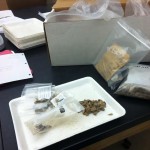Dr. Deanna Grimstead, Associate Professor in the Department of Anthropology of The Ohio State University, and her students are currently working with an Ohio Historical Society Collection from the Proctorville Village Site (Ohio Archaeological Inventory number 33LE12, collection A4197). The collection stems from a 1989 salvage excavation at the location of a large Fort Ancient Village located in Lawrence County. The goals of this project are 1) to use the collection for an introductory undergraduate and graduate level archaeological laboratory methods course, 2) to conduct a thorough zooarchaeological analysis of the archaeofaunal materials from the site, and 3) to further many more collaborative projects between the Ohio Historical Society and The Ohio State University.
Hello again readers!
I am writing to you now tantalizingly close to my graduation-a little under a month left! As such, I am smack dab in the middle of working on my big final project for my archaeology class (the one that I alluded to in my previous post). As a little refresher, I have been analyzing the ratio of small to medium/large terrestrial faunal bones over a temporal period. Although the workload is a little larger than I originally anticipated, I find merit in studying this question for several reasons. Aside my from interest in bones, my assemblage is faunal heavy so I figured I would have a lot of data to work with.
In my research I have found several factors that can contribute to changing ratios of small and large animal remains in any given archaeological site, and I am interested to see how the Proctorville site compares. This question is an important one to ask because it gives insight to how prehistoric humans had an impact on their environment, and is telling about their subsistence habits. Changing ratios might indicate changing patterns of subsistence, and may even provide an explanation for a transition to agriculture (as I have seen in some of the studies I have been using for research). Most of the research I have been doing on this topic has been based on an article by Frank Bayham done in 1979 titled Factors Influencing  the Archaic Pattern of Animal Exploitation. What I mean by this is that 95% of the rest of my research are studies that cite this paper. I am glad to have been directed to this resource from my teacher, Deanna Grimstead, because when I began my research I was at a loss of where to start. Many of the articles I have found focus on factors that influence a change in small to large faunal ratios or what might influence the differential in the archaeological record. These factors can manifest themselves in a variety of ways, whether that be the environment, subsistence patterns, or the cultural value of hunting certain animals over others. I will discuss these factors in more depth when I present my conclusion in my next post, so keep reading!
the Archaic Pattern of Animal Exploitation. What I mean by this is that 95% of the rest of my research are studies that cite this paper. I am glad to have been directed to this resource from my teacher, Deanna Grimstead, because when I began my research I was at a loss of where to start. Many of the articles I have found focus on factors that influence a change in small to large faunal ratios or what might influence the differential in the archaeological record. These factors can manifest themselves in a variety of ways, whether that be the environment, subsistence patterns, or the cultural value of hunting certain animals over others. I will discuss these factors in more depth when I present my conclusion in my next post, so keep reading!
The site from which my assemblage comes is part of the Fort Ancient culture, 1,100-400 BP. These people were farmers, but they also hunted megafauna as well as deer, caribou, and small game as well. The animals available in this region were deer, elk, turkey, bear, and small game (such as rabbits and squirrels). For my project I have identified units from the master catalogue that present a wide range of stratigraphic layers ( I have about 25 in all). Then from this, I am taking accessioned bags, sorting them between small and medium-large mammals, and counting the artifacts. From there I enter the numbers into a spreadsheet in order to create a visual representation of any trends that may or may not be present. Stay tuned for my results!
Lauren Hammersmith